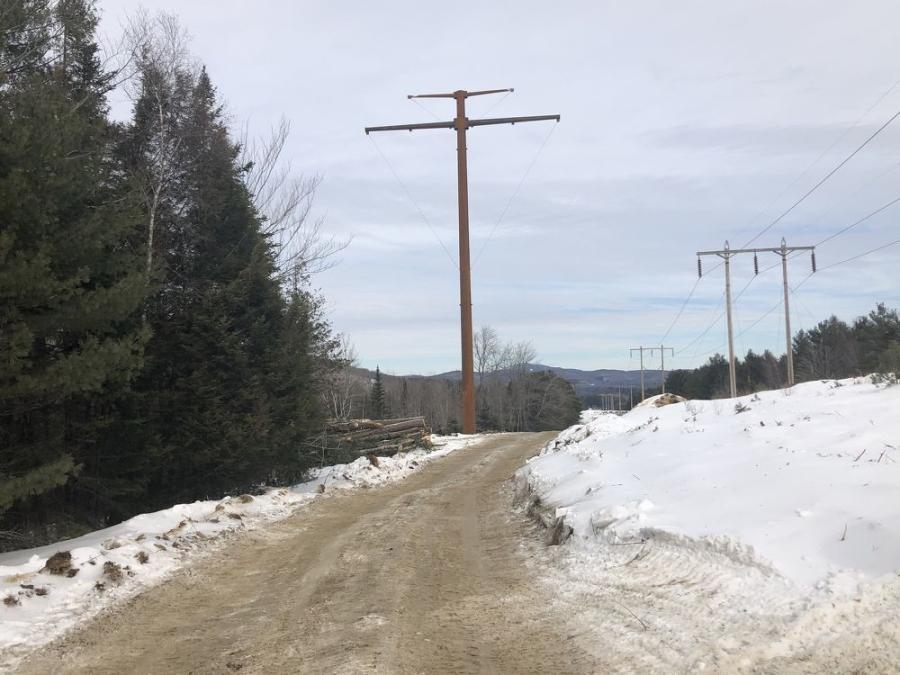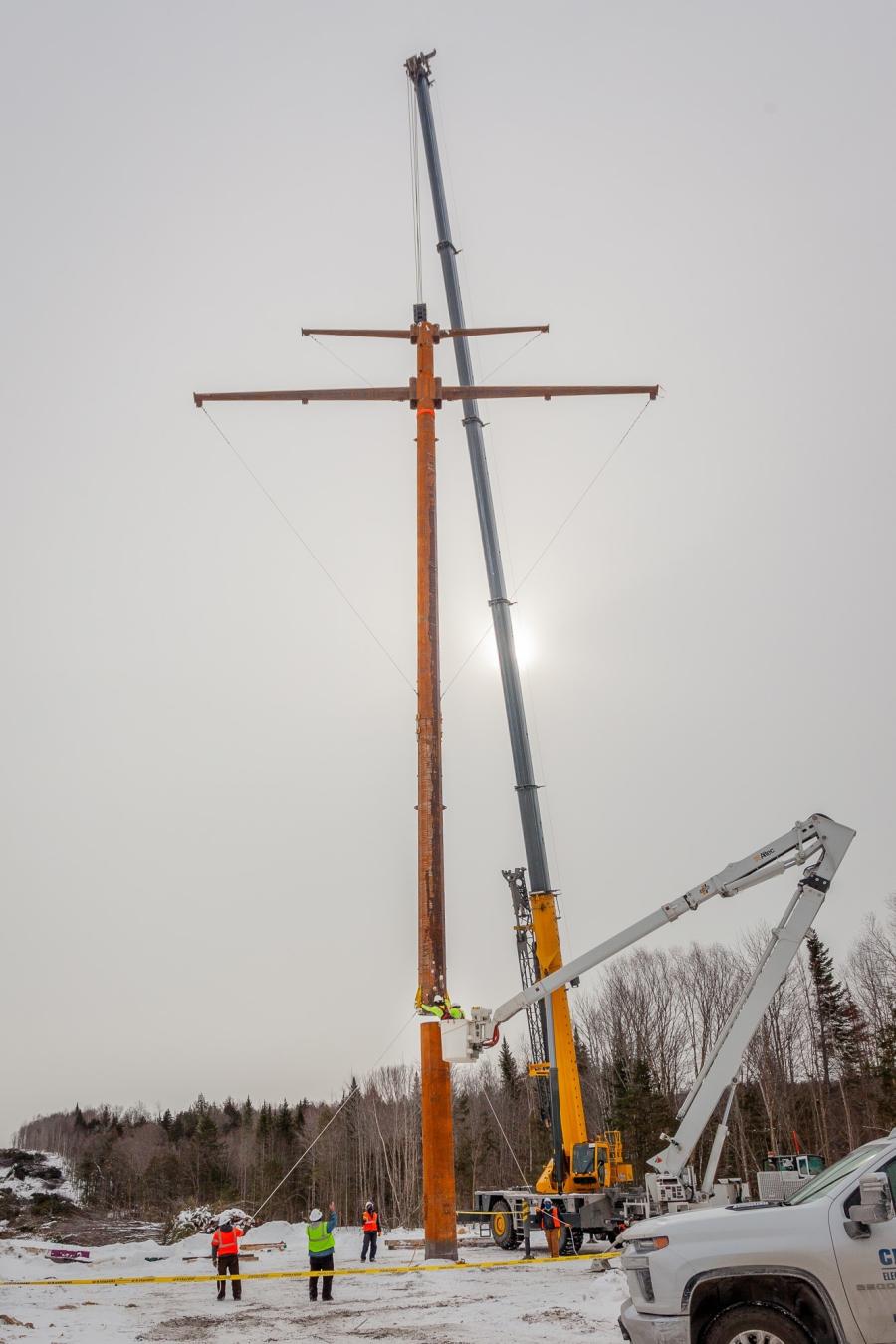The project includes 53 mi. of new transmission corridor from West Forks, Maine, to Canada.
Work on a $950 million project to bring clean energy to New England began three months ago and crews have already set a handful of the nearly 1,000 structures involved.
The New England Clean Energy Connect (NECEC) project runs 145 mi. from Maine to Canada and is expected to reduce carbon emissions in Maine and New England by 3.6 million metric tons annually as hydropower replaces fossil fuels to provide power to homes across the region.
Thorn Dickinson, president and CEO of NECEC Transmission, has been envisioning the day for at least a decade.
"The project started with three engineers sitting around a table in Maine trying to find a way and the options to bring clean energy from Quebec into New England," said Dickinson. "I think it is a fascinating story. In particular, what I find very interesting is that the majority of people in the country agree on the way forward, particularly on projects like this, where there are so clearly massive benefits of reduced carbon, but also economic benefits. This project is critical for Maine and for the region because it has such substantial environmental benefits in the reduction of greenhouse gases and such a big economic boost at a time when Maine really needs it."
The project includes 53 mi. of new transmission corridor from West Forks, Maine, to Canada, which Dickinson said will run through a logging area. The remainder of the corridor is existing.
"What we did in studying the transmission system and how we might bring power in is we prioritized using existing corridors," he said. "Two-thirds is along lines that have existed for decades. It was land we had acquired. On the new part, we had to figure out how to get from the existing corridor to Quebec. We studied the land, looked at lands that were conserved, lands that were higher impacted, tourism … we landed on a corridor to Quebec that for generations that has been heavily logged, and bought the land from two large logging companies."
The project also includes a significant upgrade to 26.5 mi. of new 345 kV transmission line between Coopers Mills substation in Windsor, Maine, and the Maine Yankees substation in Wiscasset. Additional upgrades are planned in Pownal, Sabattus and Lewiston.
In July, Maine Gov. Janet Mills OK'd a deal with Hydro-Quebec ensuring that Maine benefits from the power generated by the NECEC. Under the agreement, Hydro-Quebec will provide up to 500,000 megawatt hours of electricity a year to the state based on a 1,200-megawatt capacity of the proposed New England Clean Energy Connect.
"I have heard people say that the NECEC will deliver power directly to Massachusetts but not to Maine," Mills said. "With this new commitment, we ensure that Maine consumers access power directly from the line at a discounted price."
Hydro-Quebec also pledged to speed up disbursement of about $170 million in benefits for the state that were already promised in a deal with the state last year, including ratepayer relief and incentives for broadband expansion, electric vehicle charging stations and heat pumps, Dickinson said.
The project calls for a total of 829 self-weathering structures, including 723 monopole structures and 106 two-pole structures. During the peak season of construction,1,600 union and non-union workers will be hired for the project with a preference given to Maine residents.
In 2020, more than $320 million in contracts in connection with the project were awarded, Dickinson said. That includes $20 million in timber mat contacts split among seven Maine companies in reviewing 2020.
"The timber mats are required by the permitting agencies to cross wetlands, streams and other sensitive areas," said spokesman Ted Varipatis. "The timber mats prevent those crossings from getting rutted up and soil from being disturbed. Once the mats are in place, that gives us a travel way for both track equipment and some rubber tire equipment. Contractors will use both for this type of project. Typical equipment being used is cranes, excavators, large drills, bucket trucks, tracked dump trucks, loaders, hot saws, pulp trucks and pickups."
Major contractors are Cianbro, Northern Clearing, Irby and Sargeant Electric, all using a combination of leased and owned equipment from dealers including: Anderson Equipment Company, Nortrax Inc. and United Rentals of Maine and Enterprise Fleet Management of Missouri.
Other contracts totaling $300 million were awarded to companies building and upgrading the line that will run from Quebec to Lewiston.
In addition to the reduction in carbon emissions, other benefits include:
- 500,000 megawatts directly to Maine at below market price;
- an anticipated $18 million increase in property taxes annually in the communities the corridor will run through;
- $15 million in broadband infrastructure to improve broadband access in western Maine;
- $6 million in educational funds to provide for vocational and training programs in Franklin and Somerset counties, as well as for scholarships, internships and research at the University of Maine; and
- $2.5M for decarbonization and Maine energy resource planning studies
The transmission corridor is expected to be online in 2023. CEG
Lori Tobias
Lori Tobias is a career journalist, formerly on staff as the Oregon Coast reporter at The Oregonian and as a columnist and features writer at the Rocky Mountain News. She is the author of the memoir, Storm Beat - A Journalist Reports from the Oregon Coast, and the novel Wander, winner of the Nancy Pearl Literary Award in 2017. She has freelanced for numerous publications, including The New York Times, The Denver Post, Alaska Airlines in-flight, Natural Home, Spotlight Germany, Vegetarian Times and the Miami Herald. She is an avid reader, enjoys kayaking, traveling and exploring the Oregon Coast where she lives with her husband Chan and rescue pups, Gus and Lily.
Read more from Lori Tobias here.
Today's top stories

















